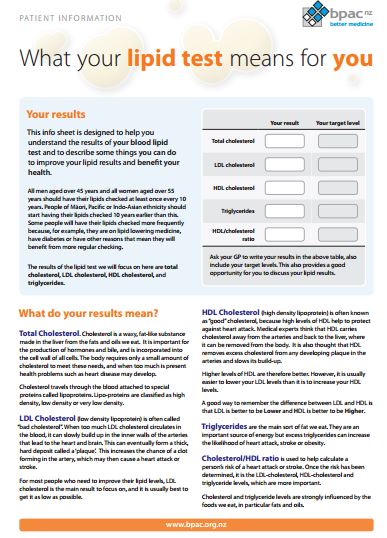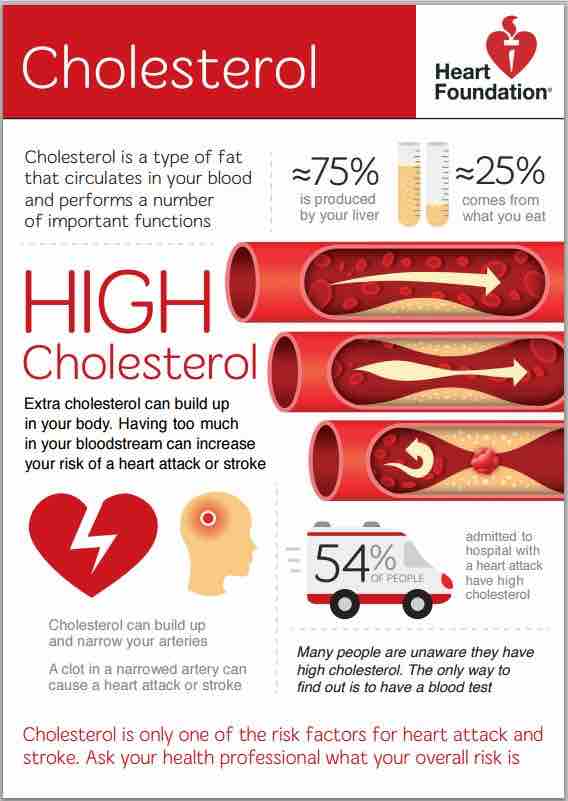Statins
Key points about statins
- Statins are a group of medicines used to lower cholesterol (or lipids) in your blood.
- Having high cholesterol increases your chance of having a heart attack, stroke or coronary artery disease.
- Find out which statins are available in Aotearoa New Zealand and the benefits and risks of taking them.

Statins are a group of medicines used to lower cholesterol (or lipids) in your blood.
Having high cholesterol can narrow your blood vessels because fat builds up and blocks the blood vessels (atherosclerosis). Cholesterol is measured in mmol/L. Having a total cholesterol above 4 mmol/L increases your chance of having atherosclerosis.
When these fatty deposits happen in the blood vessels around your heart, it’s called coronary artery disease. Having high cholesterol increases your chance of having a heart attack, a stroke or coronary artery disease.
If you have high cholesterol, even lowering it by 1 mmol/L will lower your risk of a fatal heart attack or stroke by 20%.
Statins slow down the production of cholesterol in your liver. The longer you take a statin, the more you reduce your risk of a heart attack, stroke or coronary artery disease.
Read more about high cholesterol.
In Aotearoa New Zealand, the following statins are available:
- Atorvastatin (Lorstat®).
- Pravastatin (Clinect®).
- Rosuvastatin (Crestor®, Viatris®).
- Simvastatin (Mylan/Viatris®).
Statins are used:
- if you’re at risk of having a stroke or heart attack. This is checked at a cardiovascular or heart risk assessment.(external link)
- after a heart attack or stroke to prevent another one happening.
By doing a cardiovascular or heart risk assessment your healthcare provider will build up a picture of your risk profile. This involves examining your family health history, age, weight and smoking history and diabetes status, and then testing indicators including your cholesterol levels and blood pressure.
Your healthcare provider may use a computerised tool called Predict to calculate your risk. This will give you a percentage risk of developing vascular disease and can even track your potential progress as you age.
The table below provides general information based on your cardiovascular risk.
| Cardiovascular risk | Treatment recommendations |
| Cardiovascular risk lower than 5% |
|
| Cardiovascular risk 5 to 15% |
|
| Cardiovascular risk greater than 15% OR You have a cardiovascular condition OR You've had a stroke or heart attack in the past |
|
Statins reduce cardiovascular risk by reducing LDL cholesterol (often called bad cholesterol).
- For people who have high LDL cholesterol level (≥4 mmol/L), statins can reduce LDL cholesterol by more than half.
- Reducing LDL cholesterol can help to reduce heart attacks and strokes.
- Every 1 mmol/L decrease in LDL cholesterol reduces major vascular events by approximately 25% and fatal heart attack or stroke by 20%.
Most people have few, if any, side effects from statins. The most common side effects are tummy upset such as indigestion, bloating, flatulence (wind), headache, and stuffy nose.
Muscle pain or weakness
Some people will have muscle pain or weakness when taking statins. This is rarely serious and often goes away with time. If your pain is severe, sudden or comes on shortly after you start your statin see your doctor.
Your doctor will check an enzyme called creatine kinase to see if the aches and pains are possibly being caused or made worse by the statins. If so:
- a lower dose, a different statin or another cholesterol lowering medicine may be prescribed, or
- you may choose to continue living with the aches because of the benefits of the statin, or
- you may discuss stopping taking your statin with your doctor.
Your doctor will also want to check for a rare but serious condition called rhabdomyolisis and will check any other medicines you're taking. Rhabdomyolisis can be caused by an interaction between statins and some other medicines including antibiotics.
Increased risk of type 2 diabetes
There's a small chance that statins may increase your risk of getting type 2 diabetes. However, it's usually recommended that people at risk of diabetes do take statins if they are needed to help lower their cholesterol. This is because the overall benefit in terms of health and wellbeing of taking statins and preventing a heart attack or stroke is seen to be greater than the consequences of developing diabetes.
Memory loss
There are reports that statins may affect cognitive function, mainly memory loss and confusion, and affect sleep and mood but these haven't been fully proven.
The balance of benefit and risk will differ for each person.
- For example, people at the highest cardiovascular risk will benefit the most from taking a statin. Any possible side effects from statins are likely to be thought of as a lower risk.
- On the other hand, people at a lower level of cardiovascular disease risk will have less benefit from taking a statin but have the same risk of side effects. Therefore they may feel that the risk of taking a statin outweighs the benefit.
Your doctor will discuss your cardiovascular risk with you, any possible side effects and how these could affect you.
Yes, most people will need to keep taking their statin. The benefits of reducing your risk of having a stroke or heart attack will only continue for as long as you take it. If you stop taking the statin without starting a different cholesterol-lowering treatment, your cholesterol level may rise again.
Eating a healthy diet, exercising regularly and having no more than 1 alcoholic drink a day have all been shown to improve your cholesterol levels. It's best to eat a low-fat diet, and reduce the amount of saturated fat you eat.
Read more about ways to reduce your cholesterol.
In Aotearoa New Zealand, atorvastatin is the preferred statin and is most widely used.
Some statins, eg, rosuvastatin is only available for some people if other statins haven’t worked well or if you’re of Māori or Pasifika ethnicity and are at risk of heart disease.
The choice and dose of statin will depend on your heart risk assessment or cardiovascular disease (CVD) risk – people with a lower cardiovascular risk will be on lower intensity treatments and doses than people at higher risk.
Your healthcare provider will discuss your CVD risk with you. Read more about heart risk assessment(external link).
Depending on your body’s response to the statin your doctor or nurse prescriber may increase your dose or change your treatment if you develop any side effects that bother you.
High cholesterol doesn’t have any symptoms so you won’t notice any changes after taking statins. That's why it’s important to have a blood test to check the changes in your cholesterol levels.
Most people don't feel any different or notice any side effects after starting a statin. Some people may feel muscle aches and pains in the first 6 months.
In rare cases, statins can cause serious problems with your muscles and liver. Tell your doctor immediately if you have signs of problems with your muscles and liver such as muscle pain, muscle tenderness or weakness, dark coloured urine, yellowing of the skin or eyes or a sharp pain in your stomach area.
In general the best time to take a statin is at a convenient time that suits you so that you remember to take it. It's best to take it at the same time each day.
Some people may recommend that simvastatin and pravastatin are best taken in the evening, but there is little difference in effect.
Some medicines and foods affect the way your liver can process the statin, increasing the risk of side effects.
Grapefruit is a common food that has this effect with statins. Having large quantities of grapefruit while taking simvastatin or atorvastatin can increase your risk of side effects. But, eating 1 serving of marmalade, no more than half a grapefruit or drinking no more than a standard glass (250 mL) of grapefruit juice each day, should not be a problem if you're taking statins. It's best to allow 12 hours between having these foods and taking your statin dose, so if you take your statin in the evening have your grapefruit in the morning.
Statins interact with a few other medicines, including some antibiotics so it's important that you check with your healthcare provider before taking any new medicines.
You’ll need a blood test to check that your blood cholesterol level has come down. After starting a statin, it takes about 6 weeks for cholesterol levels to stabilise, so most doctors would re-check your cholesterol after a few months. Read more about cholesterol testing.
Do I need to take coenzyme Q10 with a statin?
Statins lower the level of an enzyme in your body called coenzyme Q10, but the effect of this is unknown. Studies have tested coenzyme Q10 supplements to prevent muscle problems from statins but they mostly haven't been shown to be helpful.
Statins shouldn't be taken if you're pregnant because statins can affect development of the foetus. If you do become pregnant while taking statins, contact your doctor for advice.
There's no evidence on whether it's safe to breastfeed while taking statins, so it's best not to.
Statins(external link) Heart Foundation, NZ
Brochures
Cholesterol – what your lipid test means for you(external link) BPAC, NZ
The pros and cons of taking statins(external link) Medsafe, NZ
Cholesterol Heart Foundation, NZ English, (external link)Chinese, (external link)Hindi(external link), Korean(external link), te reo Māori(external link), Samoan(external link), Tongan(external link)
5 questions to ask about your medications(external link) Health Quality and Safety Commission, NZ English(external link), te reo Māori(external link)(external link)
References
- Statins(external link) New Zealand Formulary, NZ, 2024
- Cardiovascular disease risk assessment in primary care – managing lipids(external link) BPAC, NZ, 2018
- Prescribing statins to reduce cardiovascular risk(external link) BPAC, NZ, 2021
- Rosuvastatin – another option to lower cardiovascular disease risk BPAC, NZ, 2022
Brochures

Medsafe, NZ, 2022

BPAC, NZ, 2012
Credits: Sandra Ponen, Pharmacist, Healthify He Puna Waiora. Healthify is brought to you by Health Navigator Charitable Trust.
Reviewed by: Stephanie Yee, Pharmacist, Auckland
Last reviewed:






